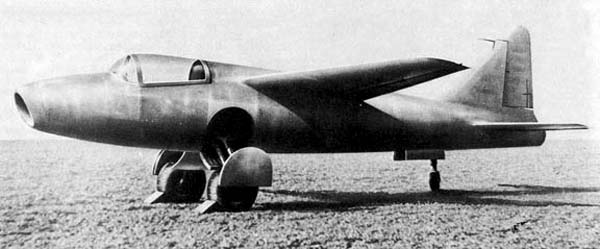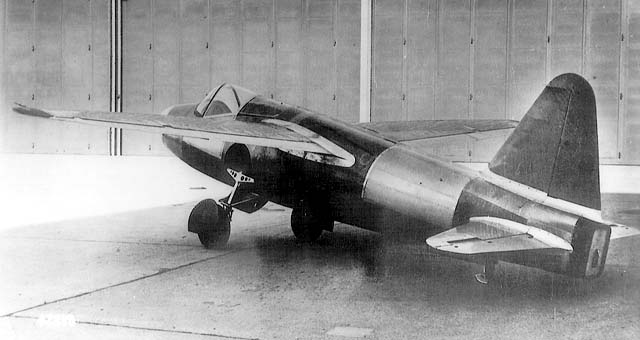Sunday 27 August 1939
 |
| The first jet airplane that flies, the He 178. |
In March 1936, Professor Fields at the University of Gottingen had written to Ernst Heinkel regarding one of his students. Hans-Joachim Pabst von Ohain had been working on a novel concept, a gas turbine using its exhaust as a means of propulsion. Pabst had even gotten a patent on the idea. Heinkel himself had been the same age as Pabst when he had gotten his own big break in the aircraft field, so he was open to the idea of a breakthrough by someone that was only 24 years old.
Heinkel gave the young inventor his own hangar to work in. Other manufacturers such as Junkers and BMW heard about the project, studied the patent and also became interested in the jet concept. The burst in interest ultimately led to the Jumo 003 engine which was the first practical jet for use in military aircraft. The British also had begun working on their own jet design, but Frank Whittle remains far behind and his prototype "Gloucester" jet would not fly until 15 May 1941.
Pabst von Ohain continued working, and by September 1937 he had his first jet engine, the HeS1 (S from Strahi = jet). Flight tests under a He-118 commenced in May 1939, by now with a HeS3 engine. The RLM (Reichsluftfahrtministerium), which directed Luftwaffe development, though, exhibits only mildly interest.
Erich Warsitz, who previously had flown the first rocket-powered plane in June 1939, performs the test flight at Heinkel's "Marienehe" factory airfield, in today's Rostock-Schmarl district. The test is a complete success and the experimental plane more than meets expectations. The RLM, though, remains unimpressed because the plane can stay in the air for no longer than ten minutes and with a top speed of "only" 378 mph (598 km/hour), which still beats any conventional aircraft of the day. The RLM chooses not to finance development (it secretly has other jet projects in the works with the other manufacturers), so Heinkel continues developing jet aircraft using its own funds. His project turns into the He 280, a solid jet aircraft ready years before the Me 262 but which never enters combat.
Only one He 178 prototype was built. It later was put on display in Berlin but destroyed in a 1943 air raid. After the war, Ernst Heinkel considers the RLM's tepid interest in jet technology to have been a classic blunder that helped cost Germany the war. After the war, Pabst von Ohain was brought to the US in Operation Paperclip and spent decades teaching and developing his ideas, primarily at Wright-Patterson in Dayton, Ohio.
German diplomacy: Birger Dahlerus returns from London with a polite but fairly neutral letter from Lord Halifax. He gives it to Goering, who immediately takes it to Hitler about 20 minutes past midnight on 27 August 1939. Hitler, who keeps late hours, reads the letter and sends for Dahlerus. The latter recalls later that Hitler was virtually incoherent and kept repeating the same phrases over and over, as if in a dream or on drugs, about annihilating England with U-boats and airplanes. Hitler eventually calms down and gives Dahlerus a new set of proposals for peace, which Dahlerus immediately flies back to London. Dahlerus returns to Berlin later in the day. The British position throughout is interesting, but not at all accommodating of Hitler's demands for peace, which include the return to Germany of Danzig and the Polish Corridor and other specific concessions.
Poland: In a football (soccer) game later memorialized as "The Last Game," Poland beats Hungary 4-2.
 |
| Another view of the first jet aircraft. |
Pre-War
8-9 November 1923: Beer Hall PutschDecember 20, 1924: Hitler Leaves Prison
September 18, 1931: Geli Raubal Commits Suicide
November 8, 1932: Roosevelt is Elected
30 January 1933: Hitler Takes Office
February 27, 1933: Reichstag Fire
March 23, 1933: The Enabling Act
June 20, 1934: Hitler Plans the Night of the Long Knives
June 30, 1934: Night of the Long Knives
August 1, 1936: Opening of the Berlin Olympics
September 30, 1938: The Munich Agreement
November 9, 1938: Kristallnacht
August 1, 1939: Flight Tests of B-17 Flying Fortress
August 2, 1939: Einstein and the Atom Bomb
August 7, 1939: Goering Tries to Broker Peace
August 14, 1939: Hitler Decides To Attack Poland
August 15, 1939: U-Boats Put To Sea
August 16, 1939: Incident at Danzig
August 20, 1939: Battle of Khalkhin Gol
August 22, 1939: Hitler Tips His Hand
August 23, 1939: Ribbentrop-Molotov Pact
August 25, 1939: Hitler Postpones Invasion of Poland
August 27, 1939: First Jet Flight
August 31, 1939: The Gleiwitz Operation
2019
No comments:
Post a Comment